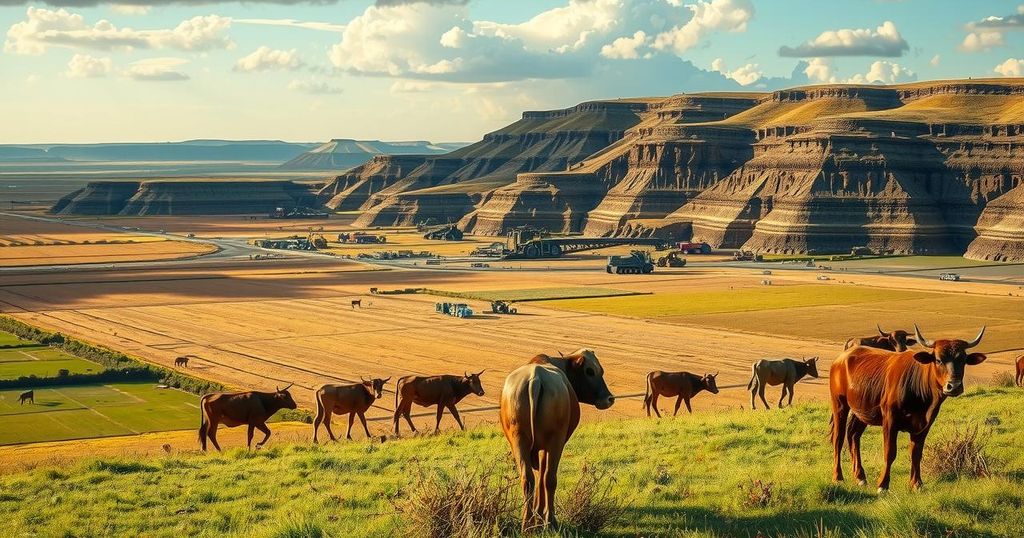Mining of Critical Minerals Tramples Grazing and Water Rights in Zimbabwe

The surge in lithium demand is jeopardizing local grazing and water rights in Zimbabwe. Several lithium mines in communal areas are complicating the protection of indigenous rights amid state-sanctioned expropriation of land to foreign companies. Concerns around inadequate compensation for affected residents and environmental risks pose ongoing challenges for sustainable mining practices.
As the demand for lithium surges, largely spurred by the shift towards electric vehicles and solar energy, challenges have begun to mount in Zimbabwe. Numerous lithium mines have been established in communal areas, which has raised significant concerns regarding local grazing and water rights. Key sites include the Mandihongola mine in Gwanda, the Sandawana lithium mine in Mberengwa, and the Arcadia lithium mine located in Goromonzi district.
The president holds the authority to expropriate land for mining activities according to section 324 of the Mines and Minerals Act. However, the situation appears complicated because the government has granted exclusive mining rights to Chinese-owned companies for these critical minerals. This raises questions about the enforcement of existing rights for local communities, especially those residing near these mines who might be losing access to vital resources.
In places like Gwanda, the lithium rock is situated near settled communal areas, affecting communities and ancestral practices that have existed for generations. Many locals express concerns that their already limited grazing lands and water resources face increasing threats from lithium mining activities. Unfortunately, compensation for land use often falls short or is completely nonexistent, leaving indigenous rights holders vulnerable.
This conflict complicates matters further, as international human rights laws do not explicitly define the right to land—though rural district councils may have jurisdiction over land use. Nonetheless, it is unclear how effective these councils are at safeguarding local rights, particularly against mining interests. The Rural District Councils’ role in preventing harmful activities that may infringe upon indigenous rights remains uncertain.
Moreover, government bodies like the Ministry of Mines and the Environmental Management Agency (EMA) have not adequately addressed the adverse impacts of lithium mining. Communities report seeing little to no return on the mining activities, despite accepting jobs that provide barely sufficient wages. Hence, there is a pressing need to protect the interests of grazing and water resources against mining operations.
Residents of Mandihongola have raised alarms over a nearby Chinese mining company that is reportedly processing about 1,000 tonnes of lithium per day. This operation is depleting local water sources and flushing waste into drinking reservoirs for cattle, which significantly jeopardizes the livelihoods of those dependent on livestock. The communities feel that their needs have not been considered in the rush for mineral extraction.
Despite the potential regulations in place for environmental protection, there is scant communication from the EMA regarding inspections of lithium mines. There have been no recent updates from the ministry responsible for environmental oversight. The lack of communication and apparent governmental silence raises concerns about whether the needs of the villagers are being prioritized. Only in the face of an impending crisis might these bodies take residents’ concerns seriously.
Additionally, Zimbabwe continues to wrestle with ongoing land degradation and water pollution caused by both artisanal miners and larger mining companies, particularly in gold mining operations. These practices not only threaten local ecosystems but also contaminate key water sources necessary for urban populations.
Penalties are codified for companies causing pollution under section 57(1) of the Environmental Management Act, which defines fines up to US$5,000 or possible prison time for negligent damage to water sources. However, rural communities often find themselves ill-equipped to enforce these regulations against more powerful mining entities.
There remains a glaring lack of comprehensive plans for the rehabilitation of lithium mining sites. With these ongoing issues, it is crucial for stakeholders to actively engage with communities to ensure livelihoods are protected and that rights are upheld in the face of rampant mineral extraction.
In conclusion, the rising demand for lithium presents significant challenges for locals in Zimbabwe, particularly around grazing and water rights. The existing legal framework, while robust, does not sufficiently protect communities against the actions of powerful mining companies. Without vigilance from government agencies and a clear strategy for balancing mineral extraction with community welfare, local rights and livelihoods remain at risk. Stakeholders must take urgent steps to engage with impacted communities and ensure their voices are incorporated into the decision-making processes surrounding mining activities.
Original Source: www.newzimbabwe.com








